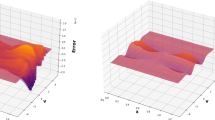Abstract
The relativistic Vlasov–Maxwell (RVM) system is a kinetic model that describes the dynamics of plasma when the charged particles move in the relativistic regime and their collisions are not important. In this paper, we formulate and investigate discontinuous Galerkin (DG) methods to solve the RVM system. When standard piecewise polynomial functions are used to define trial and test spaces, the methods conserve mass as expected. However the energy conservation does not hold due to the specific form of the total energy of the system. In order to obtain provable mass and energy conservation, we take advantage of the flexibility of DG discretizations and enrich the discrete spaces with some non-polynomial function. For the semi-discrete DG methods with standard and enriched spaces, stability and error estimates are established together with their properties in conservation. In actual implementation with the enriched space, special care is needed to reduce the loss of significance for better numerical stability. Numerical experiments, including streaming Weibel instability and wakefield acceleration, are presented to demonstrate the performance of the methods. Positivity-preserving limiter is also used in simulating wakefield acceleration to obtain physically more relevant solutions.







Similar content being viewed by others
References
Ayuso, B., Hajian, S.: High order and energy preserving discontinuous Galerkin methods for the Vlasov–Poisson system, preprint (2012)
Birdsall, C.K., Langdon, A.B.: Plasma Physics Via Computer Simulation. McGraw-Hill, New York (1985)
Califano, F., Pegoraro, F., Bulanov, S.V., Mangeney, A.: Kinetic saturation of the Weibel instability in a collisionless plasma. Phys. Rev. E 57(6), 7048–7059 (1998)
Cheng, Y., Christlieb, A.J., Zhong, X.: Energy-conserving discontinuous Galerkin methods for the Vlasov–Maxwell system. J. Comput. Phys. 279(15), 145–173 (2014)
Cheng, Y., Gamba, I.M., Li, F., Morrison, P.J.: Discontinuous Galerkin schemes for Vlasov–Maxwell system. SIAM J. Numer. Anal. 52(2), 1017–1049 (2014)
Cheng, C.Z., Knorr, G.: The integration of the Vlasov equation in configuration space. J. Comput. Phys. 22(3), 330–351 (1976)
Ciarlet, P.: The Finite Element Methods for Elliptic Problems. North-Holland, Amsterdam (1975)
Cohen, B., Langdon, A., Hewett, D., Procassini, R.: Performance and optimization of direct implicit particle simulation. J. Comput. Phys. 81(1), 151–168 (1989)
Eliasson, B.: Numerical modelling of the two-dimensional Fourier transformed Vlasov–Maxwell system. J. Comput. Phys. 190(2), 501–522 (2003)
Eliasson, B.: Numerical simulations of the Fourier-transformed Vlasov–Maxwell system in higher dimensions-theory and applications. Transp. Theor. Stat. 39(5), 387–465 (2011)
Gittelson, C., Hiptmair, R., Perugia, I.: Plane Wave Discontinuous Galerkin Methods. Isaac Newton Institute Preprint Series (2007)
Huttunen, T., Monk, P., Kaipio, J.P.: Computational aspects of the ultra-weak variational formulation. J. Comput. Phys. 182(1), 27–46 (2002)
Jacobs, G., Hesthaven, J.S.: Implicit–explicit time integration of a high-order particle-in-cell method with hyperbolic divergence cleaning. Comput. Phys. Commun. 180(10), 1760–1767 (2009)
Klimas, A.J., Farrell, W.M.: A splitting algorithm for Vlasov simulation with filamentation filtration. J. Comput. Phys. 110(1), 150–163 (1994)
Markidis, S., Lapenta, G.: The energy conserving particle-in-cell method. J. Comput. Phys. 230(18), 7037–7052 (2011)
Pegoraro, F., Bulanov, S.V., Califano, F., Lontano, M.: Nonlinear development of the Weibel instability and magnetic field generation in collisionless plasmas. Phys. Scr. T63, 262–265 (1996)
Qiu, J.-M., Shu, C.-W.: Conservative high order semi-Lagrangian finite difference WENO methods for advection in incompressible flow. J. Comput. Phys. 230(4), 863–889 (2011)
Shu, C.-W., Osher, S.: Efficient implementation of essentially non-oscillatory shock capturing schemes. J. Comput. Phys. 77(2), 439–471 (1988)
Sonnendrücker, E., Roche, J., Bertrand, P., Ghizzo, A.: The semi-Lagrangian method for the numerical resolution of the Vlasov equation. J. Comput. Phys. 149(2), 201–220 (1999)
Suzuki, A., Shigeyama, T.: A conservative scheme for the relativistic Vlasov–Maxwell system. J. Comput. Phys. 229(5), 1643–1660 (2010)
Yang, H.: Analysis and Applications of Runge–Kutta Discontinuous Galerkin Methods. Ph.D. dissertation, Rensselaer Polytechnic Institute (2014)
Yang, H., Li, F.: Error estimates of Runge–Kutta discontinuous Galerkin methods for the Vlasov–Maxwell system. ESAIM: M2AN 49(1), 69–99 (2015)
Zaki, S.I., Gardner, L.R.T., Boyd, T.J.M.: A finite element code for the simulation of one-dimensional Vlasov plasmas. i. Theory. J. Comput. Phys. 79(1), 184–199 (1988)
Zaki, S.I., Boyd, T.J.M., Gardner, L.R.T.: A finite element code for the simulation of one-dimensional Vlasov plasmas. ii. Applications. J. Comput. Phys. 79(1), 200–208 (1988)
Zhang, X., Shu, C.-W.: On maximum-principle-satisfying high order schemes for scalar conservation laws. J. Comput. Phys. 229(9), 3091–3120 (2010)
Acknowledgements
Funding was provided by National Science Foundation (Grant No. DMS-1318409).
Author information
Authors and Affiliations
Corresponding author
Additional information
This research is partially supported by NSF Grant DMS-1318409.
Rights and permissions
About this article
Cite this article
Yang, H., Li, F. Discontinuous Galerkin Methods for Relativistic Vlasov–Maxwell System. J Sci Comput 73, 1216–1248 (2017). https://doi.org/10.1007/s10915-016-0332-4
Received:
Revised:
Accepted:
Published:
Issue Date:
DOI: https://doi.org/10.1007/s10915-016-0332-4
Keywords
- Relativistic Vlasov–Maxwell system
- Discontinuous Galerkin methods
- Non-polynomial space
- Conservation
- Streaming Weibel instability
- Wakefield acceleration




